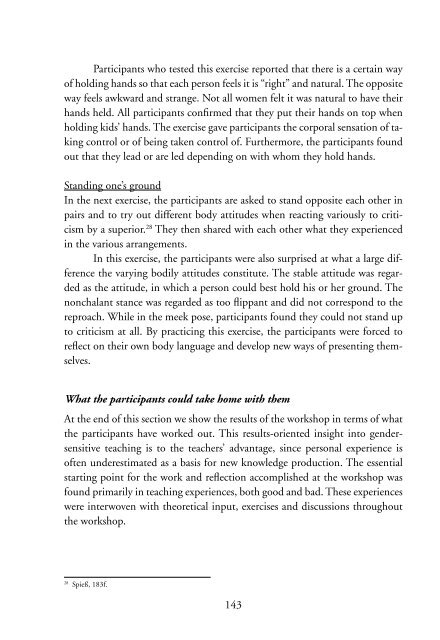Teaching with the third wave new feminists - MailChimp
Teaching with the third wave new feminists - MailChimp
Teaching with the third wave new feminists - MailChimp
You also want an ePaper? Increase the reach of your titles
YUMPU automatically turns print PDFs into web optimized ePapers that Google loves.
Participants who tested this exercise reported that <strong>the</strong>re is a certain wayof holding hands so that each person feels it is “right” and natural. The oppositeway feels awkward and strange. Not all women felt it was natural to have <strong>the</strong>irhands held. All participants confirmed that <strong>the</strong>y put <strong>the</strong>ir hands on top whenholding kids’ hands. The exercise gave participants <strong>the</strong> corporal sensation of takingcontrol or of being taken control of. Fur<strong>the</strong>rmore, <strong>the</strong> participants foundout that <strong>the</strong>y lead or are led depending on <strong>with</strong> whom <strong>the</strong>y hold hands.Standing one’s groundIn <strong>the</strong> next exercise, <strong>the</strong> participants are asked to stand opposite each o<strong>the</strong>r inpairs and to try out different body attitudes when reacting variously to criticismby a superior. 28 They <strong>the</strong>n shared <strong>with</strong> each o<strong>the</strong>r what <strong>the</strong>y experiencedin <strong>the</strong> various arrangements.In this exercise, <strong>the</strong> participants were also surprised at what a large difference<strong>the</strong> varying bodily attitudes constitute. The stable attitude was regardedas <strong>the</strong> attitude, in which a person could best hold his or her ground. Thenonchalant stance was regarded as too flippant and did not correspond to <strong>the</strong>reproach. While in <strong>the</strong> meek pose, participants found <strong>the</strong>y could not stand upto criticism at all. By practicing this exercise, <strong>the</strong> participants were forced toreflect on <strong>the</strong>ir own body language and develop <strong>new</strong> ways of presenting <strong>the</strong>mselves.What <strong>the</strong> participants could take home <strong>with</strong> <strong>the</strong>mAt <strong>the</strong> end of this section we show <strong>the</strong> results of <strong>the</strong> workshop in terms of what<strong>the</strong> participants have worked out. This results-oriented insight into gendersensitiveteaching is to <strong>the</strong> teachers’ advantage, since personal experience isoften underestimated as a basis for <strong>new</strong> knowledge production. The essentialstarting point for <strong>the</strong> work and reflection accomplished at <strong>the</strong> workshop wasfound primarily in teaching experiences, both good and bad. These experienceswere interwoven <strong>with</strong> <strong>the</strong>oretical input, exercises and discussions throughout<strong>the</strong> workshop.28Spieß, 183f.143
















